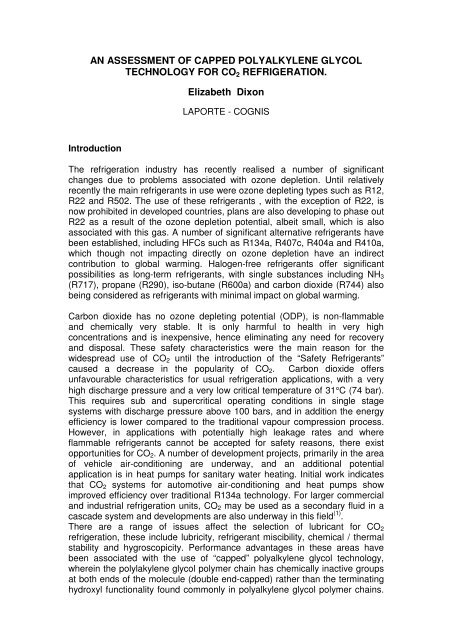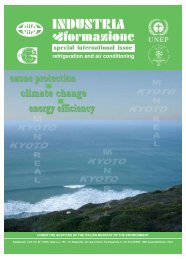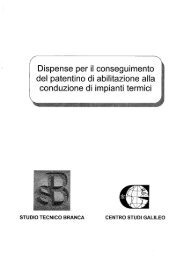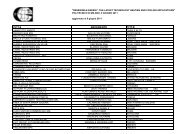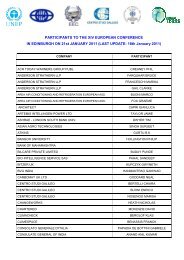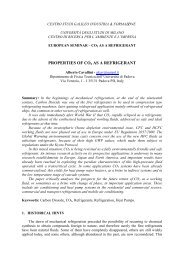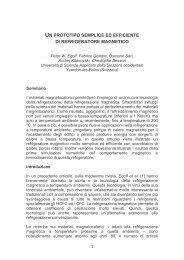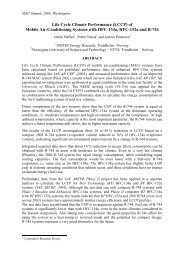An assessment of capped polyalkylene glycol technology for CO 2 ...
An assessment of capped polyalkylene glycol technology for CO 2 ...
An assessment of capped polyalkylene glycol technology for CO 2 ...
Create successful ePaper yourself
Turn your PDF publications into a flip-book with our unique Google optimized e-Paper software.
AN ASSESSMENT OF CAPPED POLYALKYLENE GLY<strong>CO</strong>L<br />
TECHNOLOGY FOR <strong>CO</strong> 2 REFRIGERATION.<br />
Elizabeth Dixon<br />
LAPORTE - <strong>CO</strong>GNIS<br />
Introduction<br />
The refrigeration industry has recently realised a number <strong>of</strong> significant<br />
changes due to problems associated with ozone depletion. Until relatively<br />
recently the main refrigerants in use were ozone depleting types such as R12,<br />
R22 and R502. The use <strong>of</strong> these refrigerants , with the exception <strong>of</strong> R22, is<br />
now prohibited in developed countries, plans are also developing to phase out<br />
R22 as a result <strong>of</strong> the ozone depletion potential, albeit small, which is also<br />
associated with this gas. A number <strong>of</strong> significant alternative refrigerants have<br />
been established, including HFCs such as R134a, R407c, R404a and R410a,<br />
which though not impacting directly on ozone depletion have an indirect<br />
contribution to global warming. Halogen-free refrigerants <strong>of</strong>fer significant<br />
possibilities as long-term refrigerants, with single substances including NH 3<br />
(R717), propane (R290), iso-butane (R600a) and carbon dioxide (R744) also<br />
being considered as refrigerants with minimal impact on global warming.<br />
Carbon dioxide has no ozone depleting potential (ODP), is non-flammable<br />
and chemically very stable. It is only harmful to health in very high<br />
concentrations and is inexpensive, hence eliminating any need <strong>for</strong> recovery<br />
and disposal. These safety characteristics were the main reason <strong>for</strong> the<br />
widespread use <strong>of</strong> <strong>CO</strong> 2 until the introduction <strong>of</strong> the “Safety Refrigerants”<br />
caused a decrease in the popularity <strong>of</strong> <strong>CO</strong> 2 . Carbon dioxide <strong>of</strong>fers<br />
unfavourable characteristics <strong>for</strong> usual refrigeration applications, with a very<br />
high discharge pressure and a very low critical temperature <strong>of</strong> 31°C (74 bar).<br />
This requires sub and supercritical operating conditions in single stage<br />
systems with discharge pressure above 100 bars, and in addition the energy<br />
efficiency is lower compared to the traditional vapour compression process.<br />
However, in applications with potentially high leakage rates and where<br />
flammable refrigerants cannot be accepted <strong>for</strong> safety reasons, there exist<br />
opportunities <strong>for</strong> <strong>CO</strong> 2 . A number <strong>of</strong> development projects, primarily in the area<br />
<strong>of</strong> vehicle air-conditioning are underway, and an additional potential<br />
application is in heat pumps <strong>for</strong> sanitary water heating. Initial work indicates<br />
that <strong>CO</strong> 2 systems <strong>for</strong> automotive air-conditioning and heat pumps show<br />
improved efficiency over traditional R134a <strong>technology</strong>. For larger commercial<br />
and industrial refrigeration units, <strong>CO</strong> 2 may be used as a secondary fluid in a<br />
cascade system and developments are also underway in this field (1) .<br />
There are a range <strong>of</strong> issues affect the selection <strong>of</strong> lubricant <strong>for</strong> <strong>CO</strong> 2<br />
refrigeration, these include lubricity, refrigerant miscibility, chemical / thermal<br />
stability and hygroscopicity. Per<strong>for</strong>mance advantages in these areas have<br />
been associated with the use <strong>of</strong> “<strong>capped</strong>” <strong>polyalkylene</strong> <strong>glycol</strong> <strong>technology</strong>,<br />
wherein the polylakylene <strong>glycol</strong> polymer chain has chemically inactive groups<br />
at both ends <strong>of</strong> the molecule (double end-<strong>capped</strong>) rather than the terminating<br />
hydroxyl functionality found commonly in <strong>polyalkylene</strong> <strong>glycol</strong> polymer chains.
Additionally, it has been identified that per<strong>for</strong>mance attributes useful <strong>for</strong> HFC<br />
and <strong>CO</strong> 2 refrigeration may be enhanced by the selection <strong>of</strong> specific<br />
terminating functionalities, achieved by capping <strong>of</strong> a single terminating<br />
hydroxyl rather than by end-capping both ends simultaneously.<br />
Single end-<strong>capped</strong> PAG<br />
8 0 0 0<br />
7 0 0 0<br />
water<br />
(ppm)<br />
6 0 0 0<br />
5 0 0 0<br />
4 0 0 0<br />
3 0 0 0<br />
D o u b l e e n d - c a p p e d P A G<br />
S i n g l e e n d - c a p p e d P A<br />
G<br />
2 0 0 0<br />
1 0 0 0<br />
0<br />
0 4 8 1 2 1 6 2 0 2 4 2 8 3 2 3 6 4 0 4 4 4 8<br />
t i m e ( h o u r s )<br />
Asymetric double end-<strong>capped</strong> PAG<br />
O<br />
O<br />
RO<br />
O<br />
OR'<br />
Where R, R’ = methyl, ethyl, butyl etc<br />
n<br />
Fig.1 Structural effect <strong>of</strong> capping on a typical α-alkyl-Ω-hydroxypolyoxypropylene<br />
polymer.<br />
Miscibility<br />
Polylakylene <strong>glycol</strong>s typically demonstrate partial miscibility with <strong>CO</strong> 2 (2) ,<br />
compared with PAO, AB and mineral oils which all show immiscibility. POE<br />
typically demonstrates good <strong>CO</strong> 2 miscibility. Miscibility <strong>of</strong> double end-<strong>capped</strong><br />
polylalkylene <strong>glycol</strong>s may be enhanced by correct choice <strong>of</strong> the terminating<br />
functionality:<br />
Figure 2 – Example <strong>of</strong> double end-<strong>capped</strong> PAG (ISO 46) miscibility with <strong>CO</strong> 2<br />
The density inversion temperature is attributable to the high variation in <strong>CO</strong> 2<br />
density with temperature, and hence a temperature is observed at which the<br />
density <strong>of</strong> <strong>CO</strong> 2 and lubricant is reversed. Whilst this point is observable in<br />
laboratory studies, the existence <strong>of</strong> a single phase without separation <strong>of</strong>
lubricant and refrigerant is observed both above and below the “density<br />
inversion temperature” <strong>for</strong> particular double end-<strong>capped</strong> PAG structures.<br />
Improved miscibility <strong>of</strong> lubricant and refrigerant is expected to result in<br />
a reduction in viscosity <strong>of</strong> the mixture, particularly with <strong>CO</strong> 2 due to the<br />
low Elizabeth Dixon<br />
LAPORTE - <strong>CO</strong>GNIS<br />
viscosity <strong>of</strong> liquid <strong>CO</strong> 2 . Whilst <strong>CO</strong> 2 miscibility <strong>of</strong> a double end-<strong>capped</strong> <strong>capped</strong><br />
PAG may be enhanced above that <strong>of</strong> a standard PAG by correct selection <strong>of</strong><br />
capping functionality, the viscosity reduction is less than that observed <strong>for</strong> a<br />
POE (3) and that which is commonly observed <strong>for</strong> a less miscible PAG.<br />
Viscosity (cSt) @ 80bar, 30% <strong>CO</strong> 2 Viscosity (cSt) @ 30bar, 10% <strong>CO</strong> 2<br />
POE 1.50 11.1<br />
Double end-<strong>capped</strong><br />
1.91 14.2<br />
PAG<br />
Double end-<strong>capped</strong><br />
PAG (<strong>CO</strong> 2 specific)<br />
2.43 19.2<br />
Table 1 – Example <strong>of</strong> viscosity reductions under <strong>CO</strong> 2 dilution observable <strong>for</strong> ISO 46<br />
lubricants.
Fig 3 – Pressure-Viscosity-temperature pr<strong>of</strong>ile <strong>of</strong> a <strong>CO</strong> 2 specific double end-<strong>capped</strong> PAG<br />
Lubricity<br />
The development <strong>of</strong> trans-critical <strong>CO</strong> 2 systems requires speciality lubricants<br />
due to the higher pressures and subsequently higher loading on bearings.<br />
The extreme pressure and anti-wear properties <strong>of</strong> PAGs are superior to<br />
POEs, and where higher ISO viscosity grade selection can be necessary with<br />
POEs due to the viscosity reduction under <strong>CO</strong> 2 dilution, this is not the case<br />
with PAGs, where lubricating properties and viscometrics are better retained<br />
under high levels <strong>of</strong> <strong>CO</strong> 2 dilution. Capped PAG <strong>technology</strong> in particular<br />
provides efficient lubrication <strong>for</strong> <strong>CO</strong> 2 refrigeration units, with improved<br />
lubricating properties being achieved as a result <strong>of</strong> the capping <strong>technology</strong>:<br />
0.6<br />
0.5<br />
0.4<br />
0.3<br />
0.2<br />
0.1<br />
0<br />
200 400 600 800<br />
Load (N)<br />
Double end-<strong>capped</strong> PAG<br />
(symetrical - ISO 46)<br />
Double end-<strong>capped</strong> PAG<br />
(symetrical - ISO 100)<br />
Double end-<strong>capped</strong> PAG<br />
(asymetrical, <strong>CO</strong>2 specific - ISO<br />
46)<br />
Double end-<strong>capped</strong> PAG<br />
(asymetrical, <strong>CO</strong>2 specific - ISO<br />
100)<br />
Figure 4 – Wear property <strong>of</strong> Capped PAGs by Falex pin & v-block (4) (atmospheric <strong>CO</strong> 2 ,<br />
100ºC) (ISO 46 & 100)<br />
The load carrying property is also observed to be partly a function <strong>of</strong> the<br />
terminating groups <strong>of</strong> the double end-<strong>capped</strong> PAG:<br />
Asymetrically double end-<strong>capped</strong> PAG<br />
(specific design <strong>for</strong> <strong>CO</strong> 2 systems)<br />
Symetrically double end-<strong>capped</strong> PAG<br />
(methyl terminations)<br />
Falex Block-on ring<br />
Failure Load (lb)<br />
380<br />
230<br />
Table 2 – EP property <strong>of</strong> <strong>capped</strong> PAGs by Falex block-on-ring (5) (10 bar <strong>CO</strong> 2 , >90ºC) (ISO 46)<br />
Chemical Stability<br />
Polyalkylene <strong>glycol</strong>s are very hygroscopic and may absorb several thousand<br />
ppm <strong>of</strong> water when exposed to humid conditions. Despite this, PAGs will not<br />
hydrolyse under such conditions and there<strong>for</strong>e do not pose any concerns<br />
regarding chemical stability. The tendancy <strong>of</strong> double end-<strong>capped</strong> PAGs to<br />
absorb water is reduced as a result <strong>of</strong> the replacement <strong>of</strong> the hydroxyl<br />
termination, and they also cannot react with any carbonic acid <strong>for</strong>med as a<br />
result <strong>of</strong> the reaction <strong>of</strong> <strong>CO</strong> 2 with water. The hydrolysis <strong>of</strong> POEs remains a
cause <strong>for</strong> concern in <strong>CO</strong> 2 systems, as in HFC systems, and copper corrosion<br />
inhibitors are necessary where copper plating is a concern.<br />
prior to test<br />
after (front)<br />
after (reverse)<br />
ISO 46 Double end-<strong>capped</strong> PAG<br />
ISO 46 POE<br />
Fig 5 - ASHRAE 97 test (14 days, R134a, 175ºC, 1.0wt% H 2 0) comparing POE and double<br />
end-<strong>capped</strong> PAG<br />
Sample<br />
TAN (unreacted)<br />
MgKOH/g<br />
TAN reacted<br />
MgKOH/g<br />
R134a<br />
Asymetrical double end-<strong>capped</strong> PAG 0.04 0.02<br />
Asymetrical double end-<strong>capped</strong> Pag + 1.0wt% H 2 0 - 0.03<br />
POE 0.22 0.37<br />
POE + 1.0wt% H 2 O - 26.0<br />
<strong>CO</strong> 2<br />
Asymetrical double end-<strong>capped</strong> PAG (<strong>CO</strong> 2 specific) 0.12 0.01<br />
Asymetrical double end-<strong>capped</strong> PAG (<strong>CO</strong> 2 specific)<br />
+ 0.1wt% H 2 O<br />
0.12 0.01<br />
Table 3 – Chemical stability by TAN comparison <strong>of</strong> <strong>capped</strong> PAGs and POE by ASHRAE 97<br />
Sealed Glass Tube Test.<br />
water<br />
(ppm)<br />
8000<br />
7000<br />
6000<br />
5000<br />
4000<br />
3000<br />
2000<br />
1000<br />
0<br />
0 4 8 12 16 20 24 28 32 36 40 44 48<br />
time (hours)<br />
Double end-<strong>capped</strong> PAG<br />
Single end-<strong>capped</strong> PAG<br />
Fig 6 – Water absorption comparison <strong>of</strong> single and double end-<strong>capped</strong> PAGs<br />
Note: (1) sample stirring speed: 500 rpm, (2) temp: 20 °C,<br />
(3) initial sample size: 30 g, (4) surface area: 3.1 cm 2 (5) Relative Humidity 52%
In addition to PAGs being chemically stable, any water absorbed by a PAG is<br />
bound by hydrogen bonding to the PAG ether linkages, and as a result the<br />
water is not “free” within the system and problems typically associated with<br />
free water such as corrosion and capillary ice <strong>for</strong>mation are prevented. The<br />
presence <strong>of</strong> free moisture in POEs remains a problem <strong>for</strong> <strong>CO</strong> 2 systems and<br />
requires handling procedures to ensure low levels <strong>of</strong> free water within the<br />
system.<br />
Conclusions<br />
A range <strong>of</strong> lubricant technologies are available <strong>for</strong> <strong>CO</strong> 2 compressor systems,<br />
with synthetic fluids such as PAGs and POEs demonstrating advantages.<br />
Double end-<strong>capped</strong> PAGs show particular per<strong>for</strong>mance advantages and may<br />
be designed to specifically enhance per<strong>for</strong>mance attributes such as <strong>CO</strong> 2<br />
miscibility and improved lubricity in high pressure systems.<br />
References<br />
(1) Rolfsmann L: <strong>CO</strong>2 Expereinces from Swedish Installations. Ashrae Transactions 2002,<br />
108 Pt1.<br />
(2) Fahl, J., Weidner, E: Polyalkylenether-Schmierst<strong>of</strong>fe für <strong>CO</strong>2-Pkw-Klima-Systeme Ki Luft<br />
und Kältetechnik 36 (2000) 10, S.478-481.<br />
(3) Hauk, A; Weidner, E: Thermodynamic <strong>An</strong>d Fluid-Dynamic Properties Of Carbon Dioxide<br />
With Different Lubricants In Cooling Circuits For Automobile Applications. Ind.Eng.Chem.Res.<br />
39 (2000) 12, S.4646-4651.<br />
(4) ASTM D2670 Standard Methods Of Measuring Wear Properties Of Lubricants.<br />
(5) Drees, D: Tribological testing, Test selection with Tribological Aspect Number. 7 th Int. LFE<br />
Congress on Lubrication, Brussels, May 20-22, 2001.


